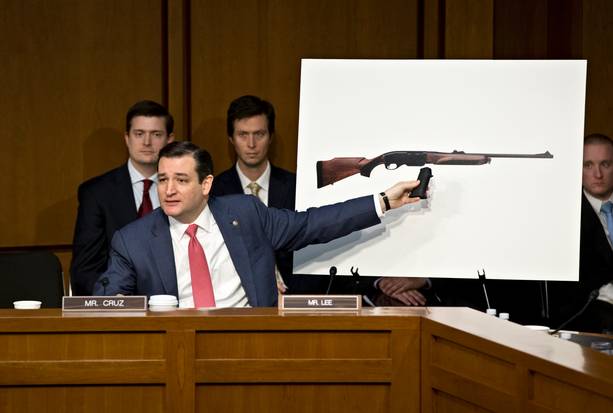Editor’s Note: The Senate filibustered criminal background checks on gun buyers on Wednesday. A bipartisan proposal crafted by Democrat Joe Manchin and Republican Pat Toomey fell short by six votes. President Barack Obama said the fight was not over but, as Reuters noted, this was his “best hope to pass meaningful gun-control legislation after the December massacre of 20 children and six adults at an elementary school in Newtown.”
Even so, as Darwin Bondgraham writes, a focus on individuals might have been ill-advised from the start. Gun makers, not gun buyers, should have been the focus of the gun control fight. The gun industry and the NRA made sure that never happened. Obama and Congress should have treated guns like cars, cigarettes and alcohol. That is, as hazardous products sold for immense profits. Otherwise, as Bondgraham writes: “No amount of regulation, education, or penalty aimed at the individual person can halt the deadly toll of guns if these they continue to flood the market.”
Gun-control legislators tend to enact laws that regulate the actions of individual gun owners and small-time gun dealers but eschew measures that would directly impact the corporations that manufacture firearms.
This time a few stringent proposals passed, but nothing that will change the status quo.
In Maryland, individual gun buyers must now submit to fingerprinting before buying a handgun. In New York, a new law allows police to trace retail-level sales of ammunition, and bans the purchase of magazines that hold more than seven rounds. In Connecticut, those who own 10 round and above magazines must register with the state, and all gun buyers must submit to background checks. Colorado’s new laws limit magazine capacity to 15 rounds, and also requires background checks for all gun purchases, including the private sales made during gun shows, or in garages.
At the federal level, where pro-gun politicians killed ambitious reforms early in the process, the surviving proposals are being heavily watered down. A renewed assault-weapons ban — one of the only measures that would directly target the gun industry by banning an entire, and highly profitable, product line — was picked off before the process was even under way. And the Senate’s enfeebled Safe Communities, Safe Schools Act would require background checks for all firearm sales, including gun shows, and prohibit straw purchases of firearms — complicating life for gun buyers and small-time gun dealers.
Meanwhile, the gun companies are nowhere in the sight.
| In the 1960s, activists targeted companies that were knowingly, or negligently, selling deadly products and pocketing huge profits. |
Not subject to consumer safety laws
The gun industry is perhaps the least regulated industry in America, even though its products kill more people than all but a few super-deadly items like cigarettes, alcohol, and motor vehicles. The tobacco, alcohol, and auto industries are all heavily regulated precisely because their products are inherently dangerous, and no amount of “personal responsibility” will reduce the number of deaths prevented by simple requirements like seat belts, or banning certain types of advertising, or heavy taxation to put the costs of morbidity and mortality on the industry.
The Federal Food, Drug, and Cosmetic Act of 1938 began the modern consumer safety movement, bringing objective scientific analysis to the impacts of consumer products to shape industrial policy and commercial law. In the 1960s, the most sweeping laws to regulate virtually every industry were passed. Activists targeted companies that were knowingly, or negligently, selling deadly products and pocketing huge profits. Basic principles of public health were applied to automobile design, drug manufacturing, food processing, children’s clothing and toys, furniture, and virtually all other products for the mass market. Millions of lives have been saved as a result.
Eventually the logic of this regulatory shift caught up with the tobacco industry, a business that was essentially based on recruiting consumers to kill themselves. The number of people who smoke has since decreased, because the industry’s huge profits were undermined, and its ability to recruit new consumers through advertising was limited. Hundreds of thousands of lives have been saved because of a public health and safety movement that pressed the state to focus on the industry behind the harms. The cost-savings to government have been enormous too.
The gun industry learned from Big Tobacco’s expensive battle against public health and safety. In the 1990s, its biggest companies organized to push back against consumer protection laws, tort lawsuits, and aggressive state and local efforts to ban their most profitable products like compact pistols and assault rifles. The result was a string of pro-gun industry laws, most notably the Tiahrt Amendments, the Protection of Lawful Commerce in Arms Act, and the de-funding of the CDC’s gun-violence research programs. Cumulatively these three victories, and a few other notable legal triumphs, give gun makers unrivaled immunity from liability lawsuits, consumer protection laws, and levels of police oversight that regulated virtually all other sectors of the economy.
Guns as public health hazard
These legislative achievements protect the gun industry’s profits. Its legislative agenda over the past two decades was a preemptive strike against a movement that could have emerged, not against guns per se, nor against the interpretation of the Second Amendment as an individual “right to bear arms,” nor even against the firearms markets at the retail level — but rather against the root of the gun problem: global corporations that amass big profits by selling increasingly deadly weapons in their last big civilian market, the United States.
| Global corporations amass big profits by selling increasingly deadly weapons in their last big civilian market, the United States. |
The industry’s agenda has been motivated not so much out of any ideological belief that guns are a source of political liberty. Rather, the gun industry has fought for its profits. Like Big Tobacco, the gun industry sells a product that is inherently designed to kill. No amount of regulation, education, or penalty aimed at the individual person can halt the deadly toll of its products.
The brilliant breakthrough of the consumer safety movement and the scientific study of public health is that what matters are structural changes that target industry practices. For most industries the transition from zero regulation to thorough regulation was painful but ultimately beneficial. Safe products make for healthy consumers who can come back and buy more.
For the sin industries like guns, smokes, and booze, safety is rather anathema, but prohibition, telling people never to drink or shoot a rifle, is simply impractical, even undesirable. But what characterizes the firearms industry today is the utter lack of power that communities have over the gunmakers and their deadly products.
America is the last best global market for guns
The gun industry’s profits have been in decline for several decades now. Tom Diaz, an expert on the firearms industry, noted the multi-decade drop in gun ownership, and total firearms sales, in the U.S. while researching Making a Killing in the late 1990s. Diaz’s latest book on guns, The Last Gun, simply restates this fact with another decade of data tacked on: “What drives the gun industry is, perhaps surprisingly, not success but failure. The civilian firearms industry in the United States has been in decline for several decades. Although it has from time to time enjoyed brief peaks in sales, it has been essentially stagnant.”
The failure Diaz mentions is a failure to expand the total sales and profits of the industry. Most other nations have been banning weapons manufacturing, imports, and instituting strict laws regarding firearms purchases and ownership. The US is virtually alone in the world in terms of its wide open gun laws, but even here gun ownership is declining.
The industry has responded with “new” must-have products like compact pistols, assault rifles, pistols capable of holding extended clips, and a mind-boggling array of military-style accessories for guns. “Tactical” weapons and add-ons have become a big money-maker, and the firearms companies have done their best to advertise these products’ military specifications.
Obama’s tenure in the White House has also provided gun companies with a big bump in sales.
Even so, the overall trend is a decline.
| “What drives the gun industry is, perhaps surprisingly, not success but failure. The civilian firearms industry in the United States has been in decline for several decades.” |
Reframing the gun debate
Within the gun industry, however, there has been a rapid consolidation of ownership and market shares. At the top of firearms industry are a few large publicly-traded corporations, a couple dozen large to medium-sized private companies, several state-owned enterprises, that have monopolized the profits still to be made making weapons. The owners of these companies, some of them quite secretive, are millionaires, and like the owners of the oil and gas industry, or the banking sector, these bosses will do what it takes to maintain and expand their sales and profits.
Today’s gun industry utilizes all the tricks of the corporate trade to keep America armed: Revolving door relationships between board members, executives, and government that provide access to lawmakers and other officials; powerful federal and state lobbyists who tackle legislation; large campaign contributions; backdoor funding of political action committees and seemingly grassroots organizations; Madison Avenue inspired advertising and product development strategies; legislative mills like the American Legislative Exchange Council to advance industry-friendly laws across states; federal contracts to boost sales and open up new overseas markets; credit and buyout equity from hedge funds to finance mergers and acquisitions; offshore tax havens to hide gun profits.
The gun violence debate is divided largely over ideological issues related to the ways that some Americans envision political freedom. The peculiar interpretation of the Second Amendment as an individual “right to bear arms” has gained mainstream acceptance since the 1960s and is largely unquestioned today, making gun-control measures such as those recently passed by the states, and currently contemplated by the Federal government, difficult to muster political support for.
However, if the gun problem were to be re-conceived of as a problem stemming from the selfish motives of a powerful, highly concentrated, global industry, proposed solutions might look different. Perhaps a shift in the debate over new laws away from gun owners and dealers, and onto the handful of corporations that run the firearms industry, would make for real progress?
Darwin Bondgraham is a sociologist and journalist who writes about political economy. His writing has appeared in Counterpunch, Truthout, Z Magazine and others. Follow him @DarwinBondGraha and @WashSpec.
Image of U.S. Senator Ted Cruz courtesy of the AP.






0 Comments